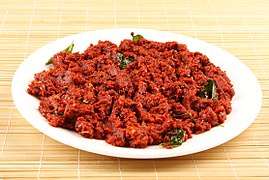Tomato chutney
Tomato chutney is a type of chutney, native to the Indian subcontinent, prepared using tomatoes as the primary ingredient.[1] The tomatoes can be diced, mashed or pulped, and additional typical ingredients used include onion, garlic, ginger, sugar, salt, vinegar and spices.[1] It can be prepared using ripe red tomatoes or green tomatoes.[2][3][4] It can be eaten fresh after preparation, stored in a refrigerator, and can be bottled or canned and stored for later use.[2][5][4] Homemade tomato chutney that is canned can have an improved flavor, due to the ingredients intermingling while the product is stored.[4]
 A tomato chutney made of tomatoes, chili peppers, onions and South Indian spices being cooked. | |
| Place of origin | Indian subcontinent |
|---|---|
| Region or state | Indian subcontinent |
| Associated national cuisine | India, Bangladesh, Pakistan |
| Main ingredients | Indian spices, tomato |
Tamtar kasundi
Tamtar kasundi originated in Bengal region, in the eastern part of the Indian subcontinent, and is typically a spicy and savory tomato and mustard chutney.[6] It is used as a condiment and dipping sauce for foods and dishes such as paratha and naan and fried foods such as samosas and pakoras.[6] It is also used as a spread on sandwiches and grilled meats.[6]
Uses
Tomato chutney can be used to accompany myriad foods and dishes, such as kebabs, sandwiches, burgers and meat dishes.[5][7]
Commercial varieties
Tomato chutney has been a mass-produced product in the United States.[8] Gordon & Dilworth in New York produced it in the 1890s–1900s (decade), and exported some of the product.[8][9]
Gallery
 Tomato chutney prepared using coriander and garlic
Tomato chutney prepared using coriander and garlic Paneer tikka with tomato chutney
Paneer tikka with tomato chutney A homemade tomato chutney
A homemade tomato chutney Another homemade tomato chutney
Another homemade tomato chutney
References
- Sudheer, K.P.; Indira, V. (2007). Post Harvest Technology of Horticultural Crops. Horticulture science series. New India Pub. Agency. p. 166. ISBN 978-81-89422-43-1. Retrieved October 27, 2017.
- Saffery, D. (2007). The Ghana Cookery Book. Jeppestown Press. p. 301. ISBN 978-0-9553936-6-2. Retrieved October 27, 2017.
- Alfeld, B.E.S. Pickles to Relish. Pelican Publishing Company. p. 153. ISBN 978-1-4556-1043-3. Retrieved October 27, 2017.
- Jeanroy, A.; Ward, K. (2009). Canning and Preserving For Dummies. --For dummies. John Wiley & Sons. p. 93. ISBN 978-0-470-50455-0. Retrieved October 27, 2017.
- Sodha, M. (2015). Made in India: Recipes from an Indian Family Kitchen. Flatiron Books. p. 21. ISBN 978-1-250-07102-6. Retrieved October 27, 2017.
- Green, A. (2015). The Magic of Spice Blends: A Guide to the Art, Science, and Lore of Combining Flavors. Quarry Books. p. 105. ISBN 978-1-63159-074-0. Retrieved October 27, 2017.
- The Simple Art of EatingWell. Countryman Press. 2013. p. 156. ISBN 978-1-58157-219-3. Retrieved October 27, 2017.
- Treasury Decisions Under the Customs, Internal Revenue, and Other Laws: Including the Decisions of the Board of General Appraisers and the Court of Customs Appeals. U.S. Government Printing Office. 1910. p. 4. Retrieved October 27, 2017.
- "El Paso Herald from El Paso, Texas on March 19, 1897". El Paso Herald. p. 4. Retrieved October 27, 2017.
External links

- Tomato Kasundi. BBC Good Food.